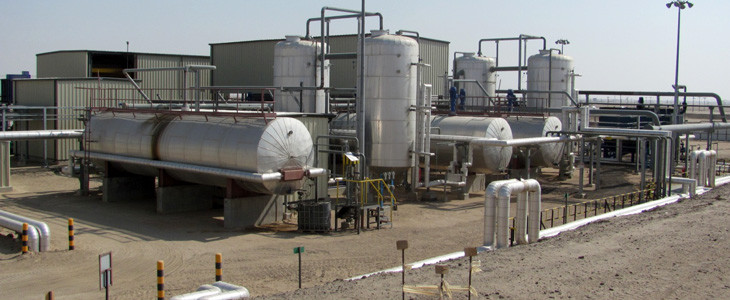Since 2011, we have produced the contractually specific amount of recycled oil with approximately 850,000 barrels of crude recovered as of the fall 2013.
As a result of years of operation, a number of large waste oil pits were created which contain on average about 800,000 to 1,000,000 barrels of weathered Eocene and Ratawi crude from various Joint Operations, Wafra (JO) production sources. The oil originally dumped into these pits had lost much of the light ends concentration due to evaporation leaving a very low API gravity oily viscous liquid material (OVL). The waste oil pits were all unlined and formed by earthen walls raised above grade. Over time, the OVL became a complex multi-phase mixture of oil, water, sediments, wind-blown sand, debris, and emulsions. The long-term weathering process had also resulted in the formation of asphaltenes in the oil phase, which tend to impart high viscosity characteristics to crude oils and negatively impact desalting and demulsification processes.
The project had two significant challenges. First, recent environmental concerns of the Government of Kuwait required the eventual closure of these waste oil pits and a restoration of the impacted area to a reasonable and achievable level of ecological functioning. Second, achieving a high crude oil recovery rate was critical since a large portion of the OVL material contained recoverable oil that could be sold on the world market at prevailing crude prices.
In November 2009, a contract was issued to Al’ Bee’a Wal Salamah General Trading & Construction Company (BWS) and its Technology Partner – PIKA International, Inc. (PIKA) – for the recovery of OVL from Pit 28A. The contract required extraction and processing the OVL for delivery of a final product to the Main Gathering Center (MGC) with a minimum API gravity of 11 and a BS&W of less than 5%. The Scope of Services required the construction and operation of a full-scale processing operation with a minimum design capacity of three thousand (3,000) barrels of recovered crude per day.
To perform the contractually specified activities and meet our clients needs, we performed services specific to the requirements, including:
- Crude Oil Reclamation
- Waste Water Treatment
- Oily Sludge Treatment
- Hazardous and Non-Hazardous Waste Services
- Process Engineering Design and Construction
- Environmental Regulatory Compliance
The treatment process includes an OVL pretreatment system (Stage 1) for gravity separation of oil, water, and sediment. Eocene crude and diesel are added to the process stream in Stage 1 to reduce the process stream viscosity and enhance separation of oil and water. Next in the process stream are two centrifugal decanters (Stage 2) for the removal of solids from the process stream.
Following the Stage 2 decanters is a disc stack centrifuge (Stage 3) for the separation of oil and water and a minor amount of residual fine solids. At this point in the process stream, the oil phase output from the centrifuge, referred to as Recycled Blended Product, is pumped back to the Main Gathering Center (MGC) through a 5,000 meter long pipeline system constructed by PIKA. The project also included the design, supply, construction, and commissioning of Eocene crude, and wastewater pipelines.
We have been producing contractually specific recycled oil since June 2011 from Pit 28A and to date approximately 850,000 barrels of crude oil have been recovered and pumped to MGC. Significant to this project also is that PIKA has maintained an impeccable safety record to date and received an “A” grade in the most recent Joint Operation CHESM safety review.
For more information, please contact us.

